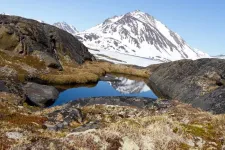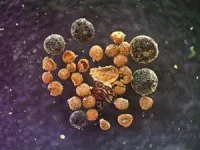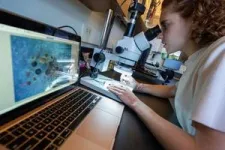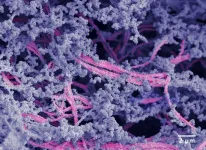(Press-News.org) The story of Greenland keeps getting greener—and scarier.
A new study provides the first direct evidence that the center—not just the edges—of Greenland’s ice sheet melted away in the recent geological past and the now-ice-covered island was then home to a green, tundra landscape.
A team of scientists re-examined a few inches of sediment from the bottom of a two-mile-deep ice core extracted at the very center of Greenland in 1993—and held for 30 years in a Colorado storage facility. They were amazed to discover soil that contained willow wood, insect parts, fungi, and a poppy seed in pristine condition.
“These fossils are beautiful,” says Paul Bierman, a scientist at the University of Vermont who co-led the new study with UVM graduate student Halley Mastro and nine other researchers, “but, yes, we go from bad to worse,” in what this implies about the impact of human-caused climate change on the melting of the Greenland ice sheet.
The study, published in the Proceedings of the National Academy of Sciences on August 5th, confirms that Greenland’s ice melted and the island greened during a prior warm period likely within the last million years—suggesting that the giant ice sheet is more fragile than scientists had realized until the last few years.
If the ice covering the center of the island was melted, then most of the rest of it had to be melted too. “And probably for many thousands of years,” Bierman said, enough time for soil to form and an ecosystem to take root.
“This new study confirms and extends that a lot of sea-level rise occurred at a time when causes of warming were not especially extreme,” said Richard Alley, a leading climate scientist at Penn State who reviewed the new research, “providing a warning of what damages we might cause if we continue to warm the climate.”
Sea level today is rising more than an inch each decade. “And it’s getting faster and faster,” said Bierman. It is likely to be several feet higher by the end of this century, when today’s children are grandparents. And if the release of greenhouse gases—from burning fossil fuels—is not radically reduced, he said, the near complete melting of Greenland’s ice over the next centuries to a few millennia would lead to some 23 feet of sea level rise.
“Look at Boston, New York, Miami, Mumbai or pick your coastal city around the world, and add twenty plus feet of sea level,” said Bierman. “It goes underwater. Don't buy a beach house.”
Core Assumptions
In 2016, Joerg Schaefer at Columbia University and colleagues tested rock from the bottom of the same 1993 ice core (called GISP2) and published a then-controversial study suggesting that the current Greenland ice sheet could be no more than 1.1 million years old; that there were extended ice-free periods during the Pleistocene (the geological period that began 2.7 million years ago); and that if the ice was melted at the GISP2 site then 90% of the rest of Greenland would be melted also. This was a major step toward overturning the longstanding story that Greenland is an implacable fortress of ice, frozen solid for millions of years.
Then, in 2019, UVM’s Paul Bierman and an international team reexamined another ice core, this one extracted at Camp Century near the coast of Greenland in the 1960s. They were stunned to discover twigs, seeds, and insect parts at the bottom of that core—revealing that the ice there had melted within the last 416,000 years. In other words, the walls of the ice fortress had failed much more recently than had been previously imagined possible.
“Once we made the discovery at Camp Century, we thought, ‘Hey, what’s at the bottom of GISP2?’” said Bierman, a professor in UVM’s Rubenstein School of Environment and Natural Resources and fellow in the Gund Institute for Environment. Though the ice and rock in that core had been studied extensively, “no one’s looked at the 3 inches of till to see if it’s soil and if it contains plant or insect remains,” he said. So he and his colleagues requested a sample from the bottom of the GISP2 core held at the National Science Foundation Ice Core Facility in Lakewood, Colorado.
Now this new study in PNAS, with support from the U.S. National Science Foundation, provides confirmation that the 2016 “fragile Greenland” hypothesis is right. And it deepens the reasons for concern, showing that the island was warm enough, for long enough, that an entire tundra ecosystem, perhaps with stunted trees, established itself where today ice is two miles deep.
“We now have direct evidence that not only was the ice gone, but that plants and insects were living there,” said Bierman. “And that's unassailable. You don't have to rely on calculations or models.”
From Flowers
The initial discovery that there was intact biological material—not just gravel and rock—in the bottom of the ice core was made by geoscientist Andrew Christ who completed his PhD working at UVM and was a post-doctoral associate in Bierman’s lab. Then Halley Mastro picked up the case and began to study the material closely.
“It was amazing,” she said. Under the microscope, what had looked like no more than specks floating on the surface of the melted core sample, was, in fact, a window into a tundra landscape. Working with Dorothy Peteet, an expert on macrofossils at the Lamont-Doherty Earth Observatory and co-author on the new study, Mastro was able to identify spores from spikemoss, the bud scale of a young willow, the compound eye of an insect, “and then we found Arctic poppy, just one seed of that,” she said. “That is a tiny flower that's really good at adapting to the cold.”
But not that good. “It lets us know that Greenland's ice melted and there was soil,” said Mastro, “because poppies don't grow on top of miles of ice.”
END
Greenland fossil discovery reveals increased risk of sea-level catastrophe
Seeds, twigs and insect parts in ice core stun scientists and confirm that center of ice sheet melted in recent past
2024-08-05
ELSE PRESS RELEASES FROM THIS DATE:
New biomaterial regrows damaged cartilage in joints
2024-08-05
Northwestern University scientists have developed a new bioactive material that successfully regenerated high-quality cartilage in the knee joints of a large-animal model.
Although it looks like a rubbery goo, the material is actually a complex network of molecular components, which work together to mimic cartilage’s natural environment in the body.
In the new study, the researchers applied the material to damaged cartilage in the animals’ knee joints. Within just six months, the researchers observed evidence of enhanced repair, including ...
Horse miscarriages offer clues to causes of early human pregnancy loss
2024-08-05
ITHACA, N.Y. – A study of horses – which share many important similarities with humans in their chromosomes and pregnancies – revealed that 42% of miscarriages and spontaneous abortions in the first two months of pregnancy were due to complications from an extra set of chromosomes, a condition called triploidy.
“Over that embryonic period [up to eight weeks from conception], triploidy had rarely been reported in mammals outside of women,” said Mandi de Mestre, professor of equine medicine at Cornell University. “The study tells us that over the first six weeks ...
Hydraulic lift technology may have helped build Egypt’s iconic Pyramid of Djoser
2024-08-05
The Pyramid of Djoser, the oldest of Egypt’s iconic pyramids, may have been built with the help of a unique hydraulic lift system, according to a study published August 5, 2024, in the open-access journal PLOS ONE by Xavier Landreau from CEA Paleotechnic Institute, France, and colleagues. The new study suggests that water may have been able to flow into two shafts located inside the pyramid itself, where that water could have been used to help raise and lower a float used to carry the building stones.
The Pyramid of Djoser, also known as the Step Pyramid, is believed ...
Honey added to yogurt supports probiotic cultures for digestive health
2024-08-05
URBANA, Ill. – If you enjoy a bowl of plain yogurt in the morning, adding a spoonful of honey is a delicious way to sweeten your favorite breakfast food. It also supports the probiotic cultures in the popular fermented dairy product, according to two new studies from the University of Illinois Urbana-Champaign.
“We were interested in the culinary pairing of yogurt and honey, which is common in the Mediterranean diet, and how it impacts the gastrointestinal microbiome,” said Hannah Holscher, associate professor in the Department of Food ...
Tradition meets transformation for Maasai women
2024-08-05
Few communities reveal both the challenges and opportunities presented by cultural globalism more than Maasai communities in northern Tanzania. Traditionally pastoralists, the Maasai ethnic group’s social structure is historically patriarchal, with a man’s prestige measured by the size of his family and by the livestock he owns.
The shrinking world has brought change: Urban centers and the promise of jobs are luring young Maasai from communities, and new technologies such as mobile phones are shifting social patterns and structures that ...
Ochsner Health nurses named to the “Great 100 Nurses of Louisiana” 2024 List
2024-08-05
NEW ORLEANS, La. – Ochsner Health proudly announces that 21 Ochsner nurses have been named to the 2024 Great 100 Nurses of Louisiana list by the Great 100 Nurses Foundation. This recognition highlights the contributions and commitment to excellence demonstrated by Ochsner’s nursing staff.
The Great 100 Nurses Foundation was established to honor nurses in Louisiana, North Carolina, Texas and Oklahoma. Each year, the foundation selects 100 nurses throughout Louisiana based on their concern for humanity, ...
Improved chemokine homing enhances CAR T–cell therapy for osteosarcoma
2024-08-05
(MEMPHIS, Tenn. – August 5, 2024) Chimeric antigen receptor (CAR) T–cell immunotherapy re-engineers a patient’s immune cells to target cancer cells. While successful in some types of leukemia, the approach has yet to realize its potential against pediatric solid tumors. Scientists at St. Jude Children’s Research Hospital have identified a way to improve CAR T–cell homing – a T cell’s ability to navigate effectively to a tumor – for osteosarcoma. Improved homing is a necessary step in designing more successful CAR T–cell therapies. The results were published today in Clinical Cancer ...
Forecasting climate’s impact on a debilitating disease
2024-08-05
In Brazil, climate and other human-made environmental changes threaten decades-long efforts to fight a widespread and debilitating parasitic disease. Now, a partnership between researchers from Stanford and Brazil is helping to proactively predict these impacts.
Schistosomiasis, spread by freshwater snails, affects more than 200 million people in many tropical regions of the world. It can cause stomach pain and irreversible consequences such as enlarged liver and cancer. Public health officials worry that deforestation, rapid urban sprawl, and changing rainfall patterns – such as ...
Deaths from advanced lung cancer have dropped significantly since immunotherapy became standard-of-care
2024-08-05
Since the first immunotherapy drug to boost the body’s immune response against advanced lung cancer was introduced in the United States in 2015, survival rates of patients with the disease have improved significantly. That’s the conclusion of a recent real-world study published by Wiley online in CANCER, a peer-reviewed journal of the American Cancer Society.
For the research, a team led by Dipesh Uprety, MD, FACP, of the Barbara Ann Karmanos Cancer Institute and the Wayne State University School of Medicine, analyzed data from the National Cancer Institute Surveillance, Epidemiology, and End Results database, which compiles cancer-related data ...
Air quality regimes around the world are playing catch up as science evolves and policy ambitions are too blunt, researchers say
2024-08-05
The failure to co-ordinate legal, policy and scientific thinking risks “a squandering of opportunity” to improve air quality, concludes new environmental law research, co-led by a UCL academic.
In their Science paper, ‘Harnessing science, policy and law to deliver clean air’, Professors Eloise Scotford (UCL Faculty of Laws), Alastair Lewis (University of York) and Delphine Misonne (UCLouvain Saint-Louis, Brussels) review recent research and highlight significant risks to achieving clean air globally.
Despite significant achievements in air quality law and policy in some parts of the world ...
LAST 30 PRESS RELEASES:
Statins significantly reduce mortality risk for adults with diabetes, regardless of cardiovascular risk
Brain immune cells may drive more damage in females than males with Alzheimer’s
Evidence-based recommendations empower clinicians to manage epilepsy in pregnancy
Fungus turns bark beetles’ defenses against them
There are new antivirals being tested for herpesviruses. Scientists now know how they work
CDI scientist, colleagues author review of global burden of fungus Candida auris
How does stroke influence speech comprehension?
B cells transiently unlock their plasticity, risking lymphoma development
Advanced AI dodel predicts spoken language outcomes in deaf children after cochlear implants
Multimodal imaging-based cerebral blood flow prediction model development in simulated microgravity
Accelerated streaming subgraph matching framework is faster, more robust, and scalable
Gestational diabetes rose every year in the US since 2016
OHSU researchers find breast cancer drug boosts leukemia treatment
Fear and medical misinformation regarding risk of progression or recurrence among patients with breast cancer
Glucagonlike peptide-1 receptor agonists and asthma risk in adolescents with obesity
Reviving dormant immunity: Millimeter waves reprogram the immunosuppressive microenvironment to potentiate immunotherapy without obvious side effects
Safety decision-making for autonomous vehicles integrating passenger physiological states by fNIRS
Fires could emit more air pollution than previously estimated
A new way to map how cells choose their fate
Numbers in our sights affect how we perceive space
SIMJ announces global collaborative book project in commemoration of its 75th anniversary
Air pollution exposure and birth weight
Obstructive sleep apnea risk and mental health conditions among older adults
How talking slows eye movements behind the wheel
The Ceramic Society of Japan’s Oxoate Ceramics Research Association launches new international book project
Heart-brain connection: international study reveals the role of the vagus nerve in keeping the heart young
Researchers identify Rb1 as a predictive biomarker for a new therapeutic strategy in some breast cancers
Survey reveals ethical gaps slowing AI adoption in pediatric surgery
Stimulant ADHD medications work differently than thought
AI overestimates how smart people are, according to HSE economists
[Press-News.org] Greenland fossil discovery reveals increased risk of sea-level catastropheSeeds, twigs and insect parts in ice core stun scientists and confirm that center of ice sheet melted in recent past






